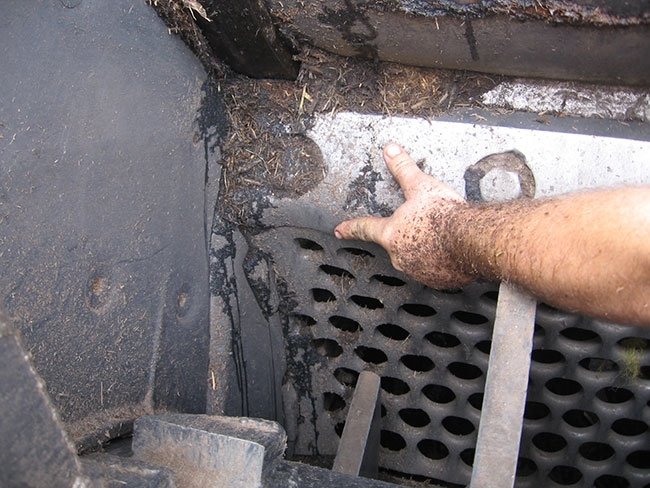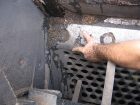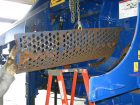
New Gear
Harvesting
New Gear
Gear Zone: a daily checklist for chipper and grinder maintenance
March 29, 2018 By Mike Delegato
 Anvils are often overlooked as wear parts. The anvil works with the grinding bits or chipper knives to cut the feed material and when it is worn the end product suffers. Maintaining the proper gap between your cutting tool and the anvil will ensure efficient processing of your feed material. Photo by Peterson Pacific Corp. As a business owner
Anvils are often overlooked as wear parts. The anvil works with the grinding bits or chipper knives to cut the feed material and when it is worn the end product suffers. Maintaining the proper gap between your cutting tool and the anvil will ensure efficient processing of your feed material. Photo by Peterson Pacific Corp. As a business ownerAs a business owner, you do not simply purchase a wood grinder or chipper, you invest hard earned money in an asset that over time is expected to produce revenue for your business. To maximize this revenue, the machine must work consistently and efficiently, producing a merchandisable product for your market. Machine downtime and inefficient operation will create excessive expenses increasing operating costs, which reduces your gross profit.
Scheduled service such as changing out air, oil, and fuel filters along with draining and replacing hydraulic and engine oil should be completed per the recommended maintenance schedule in your machine service manual. Compliance with this schedule is essential in keeping the air and oil needed to efficiently run the components on your machine clean and contaminant free. But it’s also important to stick to a daily checklist for uncovering risks that if neglected, can create costly repairs and unwanted machine down time.
Daily inspection of your chipper or grinder before and after operation should be incorporated into the daily schedule for all operators. “A 15- to 20-minute walk around the machine can end up saving you thousands of dollars in repairs,” says Bill Jensen, Peterson Pacific parts sales rep for the Pacific Northwest. “A machine inspection should be a part of the daily routine and never neglected. These are expensive machines and you can’t make money if material is not coming off the conveyor belt or out the chip spout.”
Begin your daily inspection by ensuring the battery disconnect switch is disengaged and a lockout tag is used so it is clear that the machine should not be prepped for operation. Always make safety your first priority.
“Start by looking for potential fire hazards,” Jensen says. “Material buildup around the engine and the fuel and hydraulic tanks can ignite under the right conditions.” Always remove these threats either manually or using compressed air to blow away debris from the machine.
“While I’m looking for wood buildup, I’m also searching for hydraulic oil leaks. Hydraulic oil is expensive so you want be sure to keep the oil in the tank,” he says. Major leaks need to be addressed immediately but if you feel the leak is minor, make notes and correct the problem at your earliest convenience.
The next area for inspection is the mill where the grinding and chipping of material takes place. On a grinder, always check the tips of the grinding bits to make sure the cutting edges contain sufficient carbide to make it through a shift. A worn bit is unproductive and should be turned or changed out immediately. On a chipper, sharp knives are critical to maintain chip quality. Inefficient bits or dull knives create excessive vibration on a machine. “Vibration adds stress to welds and fasteners which can lead to cracks or breaks,” says Jensen. “All components are impacted . . . fittings, hoses, tubes, pumps, motors. Minimize vibration stress as much as possible.”
Pay special attention to fasteners, which secure bits to holders and fasteners and clamps holding chipper knives in place. “Losing a bit or a chipper knife during operation can be catastrophic, loose steel tumbling free in a grinder or chipper mill creates expensive repair bills,” Jensen says. Replacing inexpensive fasteners is low-cost insurance compared to the damage that can result from a dislodged bit or knife.
The one wear part in the mill that can get overlooked is the anvil. The anvil works with the grinding bits or chipper knives to cut the feed material. “When the anvil is worn, your end product suffers” Jensen says, “and a dull anvil in a chipper will also contribute to the vibration stress.” Maintaining the proper gap between your cutting tool and the anvil will insure efficient processing of your feed material.
In the case of a grinder, an inspection of the grates is required. Grates are used to size the product once the grinding bits and anvil have reduced the feed material. Wear will dull the edges of the grate openings and material impacts can crack and weaken the webbing so change out grates when needed.
Next, take a look at your in-feed conveyor for potential problems. Clean away any material buildup under the chains. Check for loose or cracked links and link pins. Consult the owner’s manual so you are familiar with how to test the take-up tension. If the tension is too tight or too loose, adjust the tail pulley jacking bolts as needed. Your in-feed chain should run smooth without surges.
Finally, inspect your drive belts and discharge belt. Again, material buildup will disrupt the smooth operation of your belts. Check inside the drive belt guard and clear away any wood debris around the sheaves. Wood fragments can lodge in banded V-belts without penetrating the fabric wrap and should be removed. A buildup of these fragments can cause the belts to slip and smoke in this high-speed application. As with all belts, check for proper tension and adjust accordingly.
Check conveyor belts for any rips or tears and remove any material buildup under return idlers. When your inspection is complete and you start up the machine, observe the running discharge belt to determine if the belt is tracking properly. A belt that is walking will sustain damage to the edges resulting in shorter belt life.
Avoiding unexpected and expensive breakdowns by identifying potential issues before they occur is critical to keeping your grinder or chipper operating efficiently. A routine, 15-minute daily inspection will uncover these threats.
Mike Delegato is a parts marketing manager for Peterson Pacific Corp., a manufacturer of grinders, disc and drum chippers, flails, screens, stackers and blower trucks based in Eugene, Ore.
Print this page

